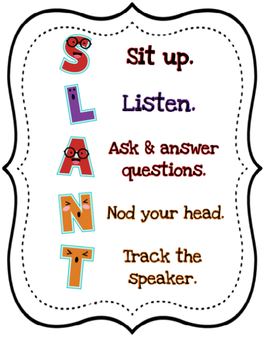- when we're upset, sad or just disagree.
- with "safe strangers" (waiter, shop clerk).
- actively, politely and assertively.
We all dutifully practiced these suggestions while she talked, of course! This was a great tool for listening at school to teachers and classmates, and also when you were having a disagreement with someone. When people feel respectfully listened to, they are more likely to compromise during a conflict.
Next, Jen was all about conversation stretchers...asking follow-up questions, asking about the other person, getting more details. All these things added up to more meaningful conversations!
Last, we tackled chatting with "safe strangers" or "friendly folks." People we came in contact with every day that maybe we didn't know, but they're generally harmless. We parents noticed our kids didn't have strategies for dealing with these periphery people. You know, when you're at church and a kind elderly woman talks to your child (who stares blankly). Or when a shop clerk asks your child about the book they're holding and she clings to your leg instead. I wrote a couple of skits for this one, and the three of us acted them out.
Pleasant People Interactions
At the store Target:
Store clerk: Hi there! That's a cute shirt you have on!
Alicia: Uh, thanks. (looks down)
SC: Can I help you find anything?
A: No thanks. (looks down and shuffles off)
Same situation:
SC: Hi there! That's a cute shirt you have on!
A: Well, thank you! (smiles) I bought it here.
SC: Terrific! Can I help you find anything?
A: I think I am fine, but thanks for asking. Bye!
Question: which has better communication and why?
At a restaurant:
Waiter: And what will you be having tonight?
E: (tugs at Mom's arm and points at menu). Looks down and mumbles, "This."
W: Would you like a salad with that, hon?
E: (nods yes)
Same scenario:
W: And what will you be having tonight?
E: Hi! I would like the chicken sandwich please. (eye contact)
W: Would you like a salad with that, hon?
E: Yes, thank you. (smiles)
Question: which has better communication? Why?
Body language played a big role in these conversations. Eye contact, using a clear voice, keeping your body open and inviting (arms not crossed, etc.), as well as smiling and nodding were mentioned as easy ways to become a better communicator.
After all this talking, it was time for some games! We came up with three game stations revolving around our themes. We divided everyone up into three groups, and each group had about 10-15 minutes per station.
1. Jenga for conversation stretchers -- While conversing, the girls played Jenga. The Jenga blocks randomly had phrases taped to them, and if you pulled one of those, you needed to use it! Jen found these great kid conversation starters/stretchers, and added ones like "Tell me more" and "How do you feel about that?"
2. Headbandz for active listening -- Have you played this game? It's really fun! Everyone wears a headband that has a word or phrase on it...you can't see your own, and when it's your turn, you have one minute to try to guess it. You can ask yes or no questions only. The phrases we used were eye contact, use a clear voice, ask about the other person, ask open-ended questions, sit up, listen, nod and track the talker.
3. Fill in the comic strips for communication with friendly folks. I used the website called makebelievecomix.com for this one -- you can create your own comic strips quickly and with ease. I started a conversation and rest was left blank to be filled in by the girls. Here are a few examples:
We ended the night with creating a human knot -- "How can we use communication to untangle ourselves?" It was pretty hilarious. Everyone was exhausted and happy by the end. An excellent evening!




